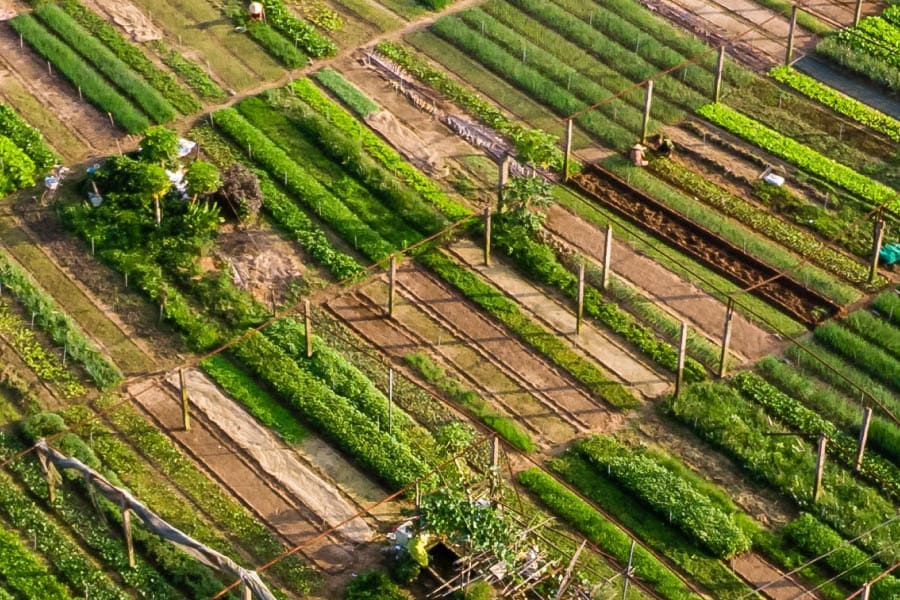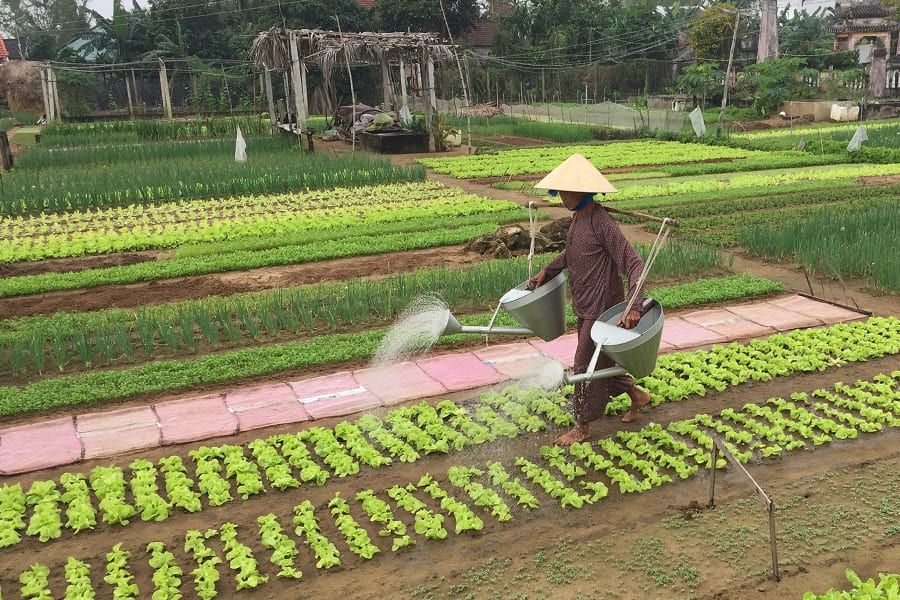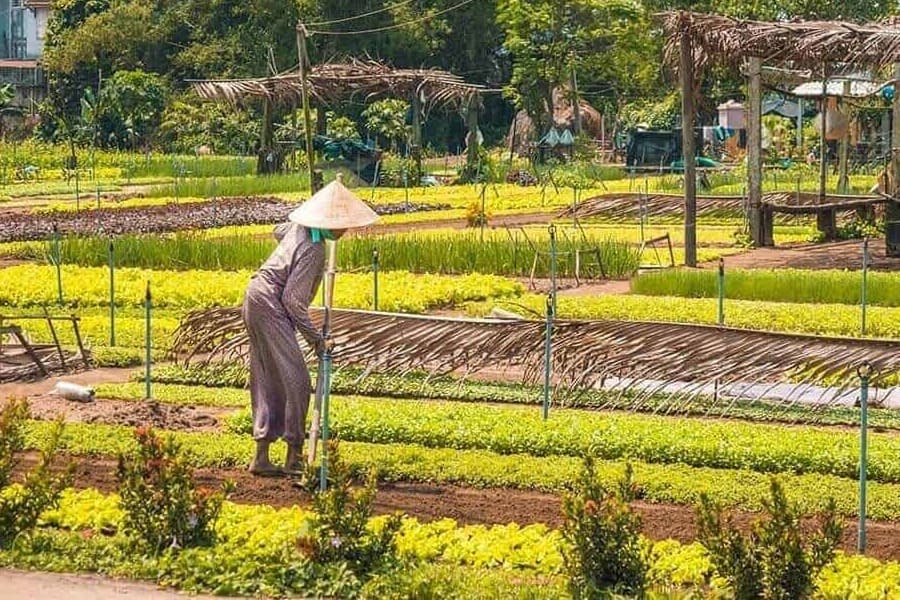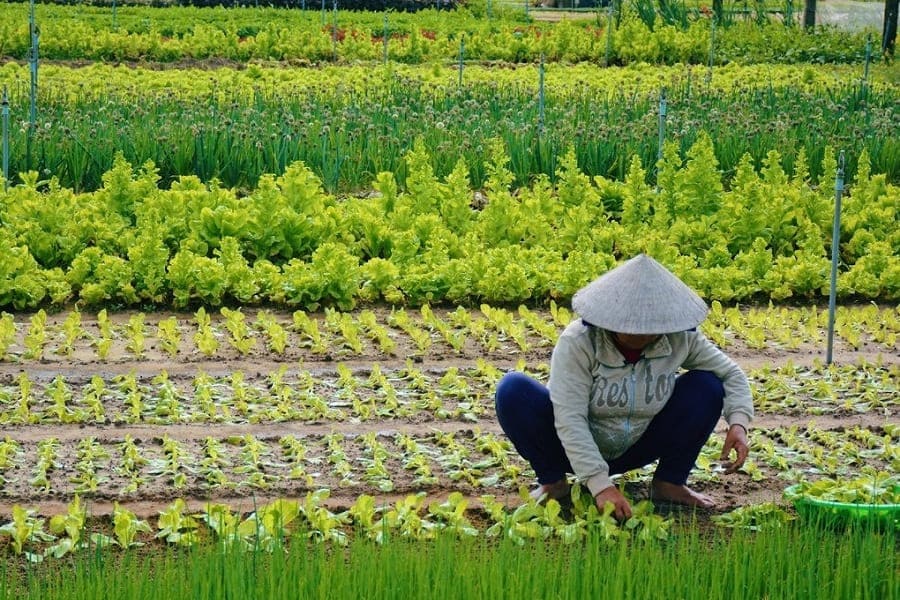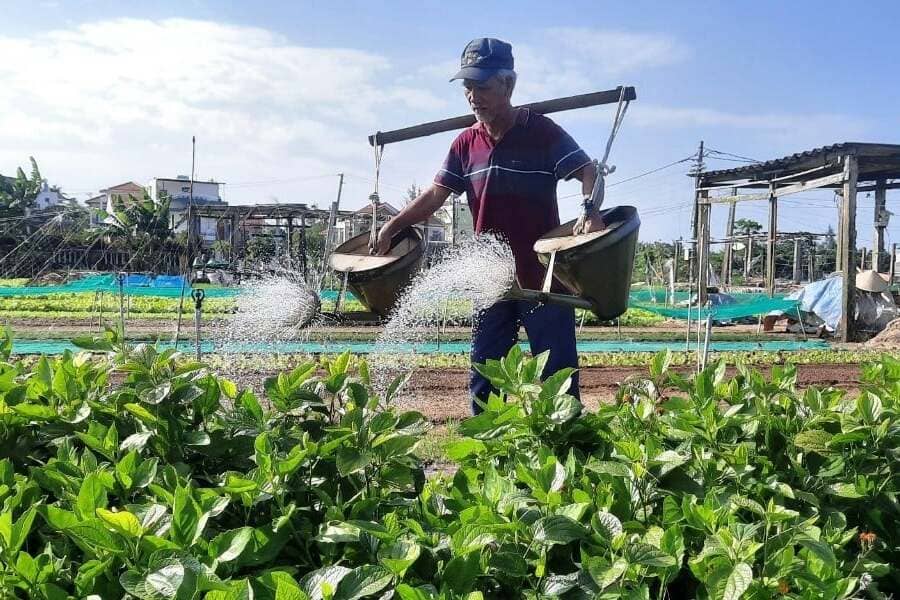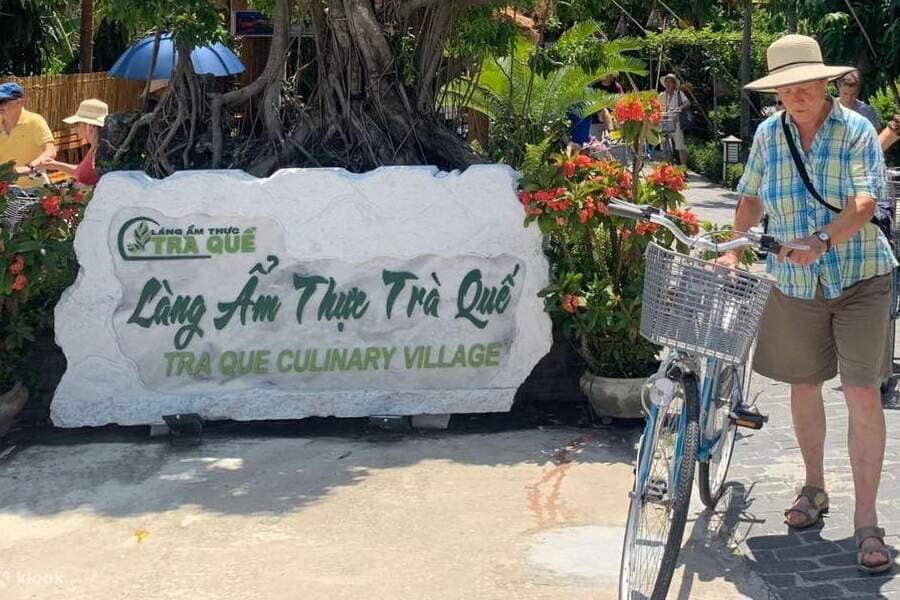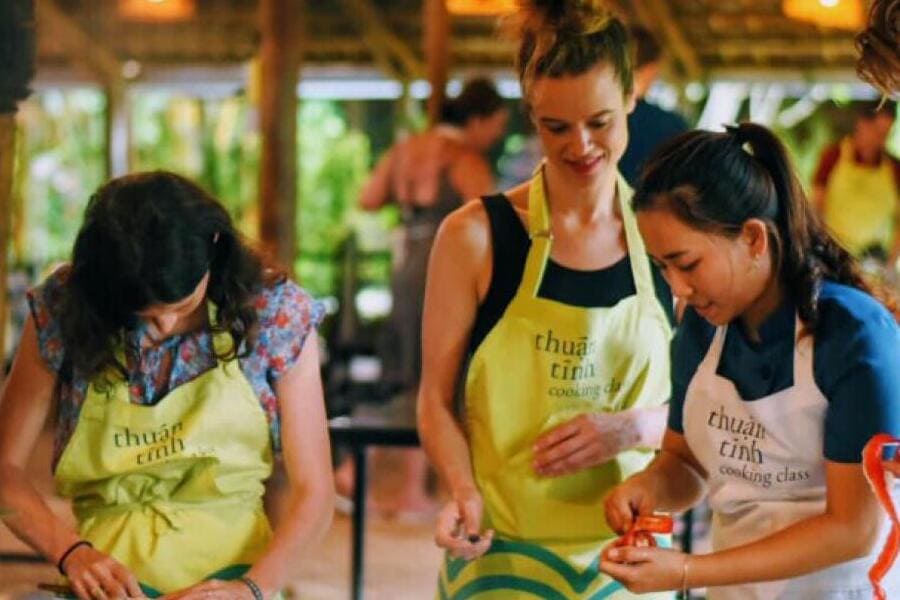Escape to Tra Que Vegetable Village, a serene oasis of organic farming just outside bustling Hoi An. This village is situated within Cam Ha commune, Hoi An City, Quang Nam province, Vietnam. Explore lush fields of aromatic herbs and vibrant vegetables, surrounded by peaceful countryside. Sample local dishes made with the freshest ingredients, and discover the village’s rich history and traditional farming methods through guided tours. Whether for relaxation or adventure, Tra Que offers cruise passengers on Hoian Shore Excursions a memorable glimpse into Vietnam’s agricultural heritage.
Introduction of Tra Que Vegetable Village
Located near Hoi An, Tra Que Vegetable Village has emerged as a sought-after destination for eco-conscious travelers. This village has gained popularity due to its commitment to sustainable practices and organic farming, which align with the growing trend of green tourism.
Visitors are drawn to Tra Que for its serene atmosphere and picturesque landscapes filled with neatly arranged vegetable gardens. The village offers a tranquil escape from the hustle and bustle of urban life, inviting guests to immerse themselves in the natural beauty of the countryside.
What sets Tra Que apart is its emphasis on traditional farming techniques that use organic fertilizers and clean irrigation methods, ensuring the production of high-quality vegetables. This eco-friendly approach not only supports local agriculture but also provides visitors with an authentic cultural experience.
Whether exploring the lush fields of aromatic herbs, participating in farming activities, or sampling fresh dishes made from local produce, Tra Que Vegetable Village promises a unique and enriching journey into sustainable living and rural Vietnamese life.
Explore the history and evolution of Tra Que Vegetable Village
Tra Que Village, located near the Co Co River in central Vietnam, originally thrived as a fishing and aquaculture center due to the river’s fertile grounds and abundant water resources. As settlers explored the area, they discovered nutrient-rich alluvial soil along the riverbanks, perfect for cultivating diverse crops like basil, coriander, and medicinal plants alongside traditional fishing practices.
Over time, the village shifted its focus from fishing to agriculture as residents recognized the economic advantages and food security benefits of vegetable farming. The natural irrigation from the Co Co River and nutrient deposits during floods facilitated year-round crop production, bolstering the local economy.
Nowadays, Tra Que Village continues to uphold its agricultural heritage while adopting modern, organic farming techniques. With approximately 40 hectares under cultivation, it produces over 20 types of high-quality, chemical-free vegetables. This transformation has positioned Tra Que as the primary vegetable supplier for Quang Nam and Da Nang provinces, supplying local markets, restaurants, and supermarkets.
In addition to its agricultural prowess, Tra Que attracts eco-tourists interested in farm-to-table experiences and cultural immersion. This dual identity as both a thriving agricultural center and a sought-after tourist destination underscores Tra Que’s vital role in the regional economy and cultural preservation.
Organic Farming Practices in Tra Que Vegetable Village
Organic farming emphasizes clean water for irrigation and seaweed-based organic fertilizers, ensuring the production of high-quality vegetables prized by consumers for their purity and nutritional value. Clean water from local sources and organic fertilizers derived from seaweed enrich the soil naturally without synthetic chemicals, supporting sustainable agriculture.
Tra Que cultivates a diverse range of vegetables including basil, coriander, and leafy greens using organic methods. This ensures vegetables are free from chemical residues, appealing to health-conscious consumers. The village’s commitment to organic practices not only meets consumer preferences for healthy, high-quality produce but also supports environmental sustainability and local economic growth. Organic farming techniques preserve soil health and biodiversity while enhancing community livelihoods.
Ideal Time to Visit Tra Que Vegetable Village
The best times to visit Tra Que Vegetable Village are from February to April and August to December when Central Vietnam experiences mild weather. Early mornings and late afternoons offer cooler temperatures and softer sunlight, perfect for leisurely walks and farm tours. These seasons support lush vegetable growth, creating a vibrant environment for outdoor activities like farm-to-table experiences and cooking classes with freshly harvested produce. It’s an ideal opportunity to immerse yourself in Tra Que’s agricultural rhythms and scenic beauty.
Entrance fee information to Tra Que Vegetable Village
Entrance to Tra Que Vegetable Village costs 35,000 VND per person.
Ecotourism Activities
Explore farm-to-table experiences, cooking classes with fresh vegetables, cultural exchanges with local farmers, guided tours showcasing organic farming, and opportunities for relaxation amidst serene surroundings.
Experiences and Activities in Tra Que Vegetable Village
Photography Opportunities in Natural Surroundings
Capture stunning shots amidst Tra Que Village’s picturesque landscapes, featuring lush green fields, traditional farming methods, and serene waterways like the Tra Que lagoon and De Vong River.
Participatory Farming Experiences
Engage in hands-on farming activities such as planting seeds, harvesting vegetables, and tending to crops alongside local farmers. Learn about organic farming practices and the agricultural rhythms that sustain the village’s rich vegetable production.
Interaction with Local Farmers and Cultural Activities
Interact with friendly local farmers to understand their daily lives and traditional farming techniques. Participate in cultural activities such as fishing using traditional nets or riding water buffaloes, gaining insights into rural Vietnamese customs and heritage.
Join cooking classes where you’ll use freshly harvested vegetables to prepare authentic Vietnamese dishes under the guidance of skilled chefs.
Immerse yourself in the tranquility of the countryside, enjoying peaceful moments amidst the greenery and fresh air.
Culinary Experiences in Tra Que Vegetable Village
Cooking Classes with Fresh, Harvested Vegetables
Immerse in Vietnamese cuisine with hands-on cooking classes at Tra Que Vegetable Village. Work directly with freshly harvested vegetables from the village’s organic gardens, guided by local chefs. Learn to prepare authentic Vietnamese dishes celebrated for their freshness and rich flavors.
Experience farm-to-table dining by selecting seasonal vegetables for your dishes, ensuring peak freshness. Master recipes like Cao Lau, Banh Xeo, or Pho, infused with aromatic herbs grown in Tra Que’s fertile soil. Gain insights into culinary traditions and techniques, and conclude with a communal meal that fosters cultural exchange amidst the village’s agricultural heritage.
Culinary Experiences in Tra Que Vegetable Village
Embark on a culinary journey in Tra Que Vegetable Village, where you’ll discover the richness of Vietnamese cuisine amidst picturesque organic gardens and tranquil surroundings.
Quang Noodles (Mi Quang) is a specialty dish from Quang Nam Province. This hearty noodle dish features turmeric-infused noodles served with shrimp, pork, quail eggs, fresh herbs, and a flavorful broth.
Cao Lau is a dish unique to Hoi An. This noodle dish combines thick rice noodles with slices of pork, crispy pork rinds, fresh herbs, and a rich, savory broth infused with local spices.
Banh Xeo is a crispy Vietnamese pancake filled with shrimp, pork, bean sprouts, and mung beans. Wrap it in fresh lettuce leaves and herbs, dipping it into a tangy fish sauce for an explosion of flavors.
Tam Huu Dish is a specialty of Tra Que Vegetable Village. This dish consists of shrimp and pork wrapped with aromatic herbs like basil, perilla leaves, and lettuce, served with a dipping sauce of fish sauce, lime, and chili.
Gain insights into using Tra Que’s renowned aromatic herbs such as basil, coriander, mint, and perilla in your dishes. Discover how these herbs enhance the flavors and textures of traditional Vietnamese cuisine.
Conclude your culinary adventure with a communal dining experience, sharing the fruits of your labor with fellow participants. Enjoy the camaraderie and vibrant flavors, celebrating the essence of Vietnamese hospitality and cuisine.
Special Events in Tra Que Vegetable Village
By participating in special events like the Cau Bong Festival, visitors can enjoy a rich cultural immersion and gain a greater appreciation for the unique traditions and agricultural practices of Tra Que Vegetable Village.
Cau Bong Festival
Held every January, the Cau Bong Festival marks the start of the lunar new year. This festival is a time for villagers to honor their ancestors and pray for a prosperous farming season. Traditional rituals and ceremonies are conducted to seek blessings for abundant crops and favorable weather.
Agricultural Celebration
The festival celebrates the village’s agricultural heritage, showcasing the importance of farming in Tra Que. It is a time to appreciate the hard work of farmers and the natural bounty of the land.
Engaging Activities
Festivals often feature traditional music, dance, and other cultural performances, providing an immersive experience of Vietnamese culture.
Joining these celebrations allows tourists to bond with residents, fostering a sense of connection and appreciation for the village’s cultural and agricultural heritage.
Are you ready to experience Tra Que Vegetable Village?
Vietnam shore excursions provide access to Tra Que, a traditional craft village that has evolved into an international tourist hotspot. This serene oasis blends cultural richness and culinary delights, offering visitors a peaceful atmosphere, lush fields, and traditional farming practices to enjoy. Nowadays, Tra Que also boasts high-quality produce and provides unforgettable experiences that connect visitors to Vietnamese culture and cuisine

